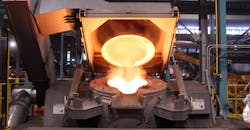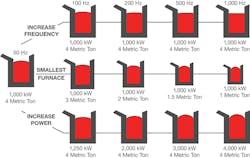Selecting the Right Unit for Efficient Induction Melting
There are two basic types of induction melting furnaces that have been in use since the early 1900s. First came channel furnaces, operating with mains frequency, and then many foundries switched to smaller coreless furnaces, for which a range of frequencies (from medium to high) were used. Channel furnaces were originally developed to melt brass but now are commonly used for copper, bronzes, zinc, aluminum and iron. Coreless furnaces are commonly used for virtually all metals.
Channel furnaces produce heat for melting by utilizing the principle of the short-circuited iron core transformer. Alternating current is passed through a multiple-turn primary coil surrounding an iron core. The secondary is a loop of molten metal surrounding the primary and the core. Current flowing through the primary induces a much larger current in the metal loop, whose resistance creates heat for melting.
Core-Type Channel — Channel furnaces are the most efficient type of induction furnace because their iron core concentrates magnetic flux in the molten loop, ensuring maximum power transfer from primary to secondary. Efficiency in the use of power can be as high as 95 to 98%.
Channel furnaces are most effective for high-production operations that need: a large throughput of metal; continuous and multi-shift casting schedules; few alloy changes; holding capacity for shift melting operations to take advantage of off-peak energy savings; and power demand limiting. Channel furnaces are an economical way to hold a large quantity of molten metal for an extended period of time to provide a continuous supply of ready-to-pour metal, seven days a week. Melting can take place during off-peak energy demand periods in a coreless furnace and then the molten metal can be stored in the channel furnace and tapped for production during on-peak hours.
However, an essential loop of metal must be maintained continuously in a channel furnace. If allowed to freeze, extreme care is necessary in remelting because the loop may rupture and disrupt the circuit. This could require extensive work to restore the loop, or the furnace may need to be disassembled completely and relined. Consequently, channel furnaces rarely are permitted to cool, which makes alloy changes difficult because a heel of molten metal always is required.
Another consideration is the need to keep the relatively narrow melting channels as clean as possible. Slag may build up on the channel walls, restricting the free flow of metal and cause overheating.
Operating characteristics of this kind of furnace are constant, and refractory lining life is good because of the constant temperature. Depending on the metal being melted, uppercase lining life may extend several years and for millions of pounds of molten metal, with proper maintenance. Channel furnaces are ideally suited to melting a single alloy as a holding vessel or as a pressure-pour furnace.
Coreless-Type — A coreless induction furnace operates at low, intermediate and high frequencies — from 60 to 10,000 cycles/second — and is unmatched for flexibility. It also operates by transformer action, but in this case it is similar to an air-core transformer. The primary coil induces current directly in the metal charge, which is contained in an unobstructed crucible or refractory lining. There is no internal melting loop or channel. The primary winding is a water-cooled copper coil surrounding the outside of the crucible or refractory lining.
The coreless furnace can be started cold and usually is poured empty. This greatly simplifies alloy changes and makes it possible to shut down as desired.
Linings of coreless furnaces may be as durable as core-type furnace linings in applications where a molten charge is maintained 24 hours a day. Because of alloy changes or analysis control, however, batch melting is the usual practice and the recurring heating and cooling results in less lining life. On the other hand, these linings are considerably less expensive and can be changed quickly.
Because there is no flux-concentrating core as on core-type furnaces, the efficiency of the coreless furnace usually is lower than that of core-type furnaces. Normal efficiency is approximately 75%. Smaller coreless furnaces are designed to operate at higher frequencies in order to maintain good efficiency and proper stirring action.
When a furnace is operated at a frequency lower than ideal the result may be a violent stirring action that may produce inclusions of slag and refractory particles, as well as gas pickup. Metal loss may be excessive due to excess surface area of the melt and oxidation of volatiles, making startup harder, and thus it may be necessary to charge with greater care. Additionally, some types of scrap cannot be used for starting.
In many cases the most important fact is that lining life can be reduced by using too low of a frequency. On the other hand, if too high a frequency is selected for the size of the furnace, there may be a complete lack of stirring, uneven heating throughout the charge, excessive side-wall temperatures and difficulty in attaining homogeneous melts.
The experience of stirring gained over the past several years has been crucial for the foundry industry and those who desire high power densities. Much of the research on furnace size and frequency has been summarized in an easy-to-read chart that is very often used to properly size induction melting equipment.Additional Benefits — Many ferrous and nonferrous foundries hesitate to use chips because of the possible melt contamination and resulting poor quality due to presence of gas in the melt. With induction melting, because of the constant temperature and excellent stirring action, chips often can be used successfully and significant savings can be achieved.
One nonferrous foundry melts 300 lbs. of brass chips per heat. Each charge of chips represents a significant savings. The plant manager says that he collects only a small bucket of slag and dross from seven successive heats now, in contrast to the drum-full he collected before he installed an induction melting furnace. Another foundry reported two weeks’ production of 75,000 lbs. resulted in only a half drum of slag and dross.
The use of chips and other forms of metal scrap in induction melting is growing rapidly, spurred perhaps by the trend towards more efficient scrap handling and classification. The important factor is that the individual pieces of the cold charge should have a uniform composition.
Steel Foundries—Producers of steel and stainless-steel castings must invest heavily in melting equipment, but a careful choice of such equipment can return substantial savings.
Induction melting equipment normally requires a relatively high grade of melting scrap, but this extra cost to an alloy steel foundry usually is less important than to nonferrous foundries. It depends on the alloy and the selling price of the product. If a foundry is producing mainly carbon steel or low-alloy castings, the cost of higher-grade scrap may be significant.
Temperature Control and Melting — Temperature control with induction melting is accurate and rapid. Applying indirect power for only a minute or two will increase temperature 100°F. There’s little chance that carbon pickup will get out of hand, reducing the number of melt analyses.
The stirring action in a properly sized induction furnace produces a homogeneous melt without gas pickup, refractory inclusions or alloy loss. Melting times can and should be exceedingly fast. Typical recommended melting times for iron are as follows: 300-500 lbs. in about 22 minutes; 750 lbs. in about 27 minutes; 1,000 lbs. in about 36 minutes. As a rule, it pays to avoid melting times exceeding 1 hour for any melt less than 4,000 lbs. For larger furnaces, you may want to contact an induction equipment supplier for the most accurate melt times, as these may vary according to alloys and furnace sizes.
Michael Fanz-Huster is a District Manager for Inductotherm Corp. Contact him at [email protected], or visit www.inductotherm.com
About the Author
Michael Fanz-Huster
Michael Fanz-Huster is a District Manager for Inductotherm Corp. Contact him at [email protected], or visit www.inductotherm.com


